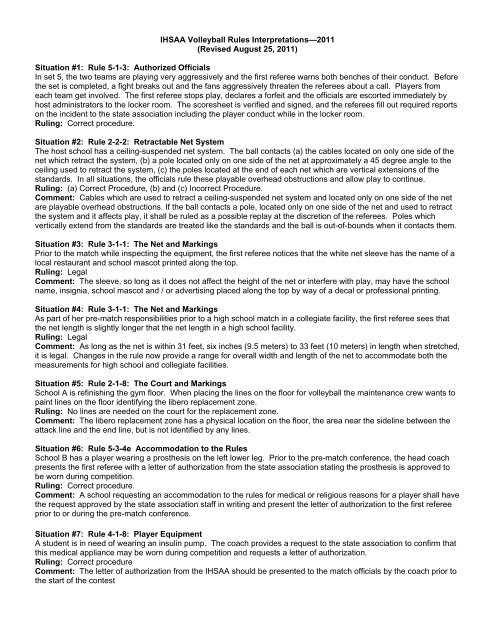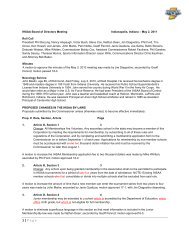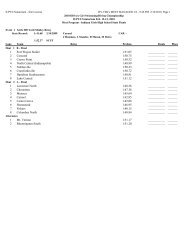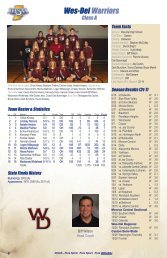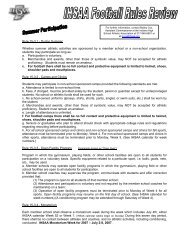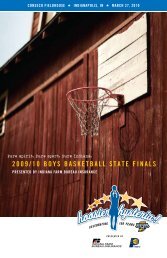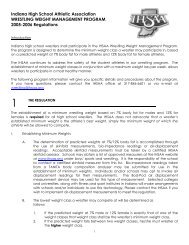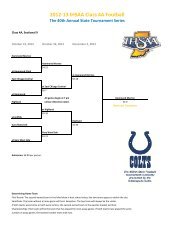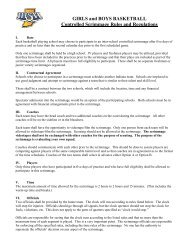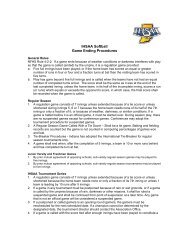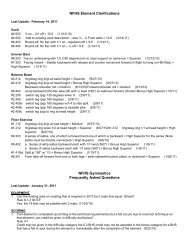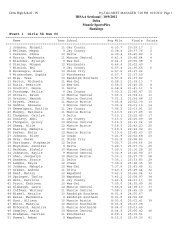2011-12 IHSAA Rules Interpretations
2011-12 IHSAA Rules Interpretations
2011-12 IHSAA Rules Interpretations
You also want an ePaper? Increase the reach of your titles
YUMPU automatically turns print PDFs into web optimized ePapers that Google loves.
<strong>IHSAA</strong> Volleyball <strong>Rules</strong> <strong>Interpretations</strong>—<strong>2011</strong><br />
(Revised August 25, <strong>2011</strong>)<br />
Situation #1: Rule 5-1-3: Authorized Officials<br />
In set 5, the two teams are playing very aggressively and the first referee warns both benches of their conduct. Before<br />
the set is completed, a fight breaks out and the fans aggressively threaten the referees about a call. Players from<br />
each team get involved. The first referee stops play, declares a forfeit and the officials are escorted immediately by<br />
host administrators to the locker room. The scoresheet is verified and signed, and the referees fill out required reports<br />
on the incident to the state association including the player conduct while in the locker room.<br />
Ruling: Correct procedure.<br />
Situation #2: Rule 2-2-2: Retractable Net System<br />
The host school has a ceiling-suspended net system. The ball contacts (a) the cables located on only one side of the<br />
net which retract the system, (b) a pole located only on one side of the net at approximately a 45 degree angle to the<br />
ceiling used to retract the system, (c) the poles located at the end of each net which are vertical extensions of the<br />
standards. In all situations, the officials rule these playable overhead obstructions and allow play to continue.<br />
Ruling: (a) Correct Procedure, (b) and (c) Incorrect Procedure.<br />
Comment: Cables which are used to retract a ceiling-suspended net system and located only on one side of the net<br />
are playable overhead obstructions. If the ball contacts a pole, located only on one side of the net and used to retract<br />
the system and it affects play, it shall be ruled as a possible replay at the discretion of the referees. Poles which<br />
vertically extend from the standards are treated like the standards and the ball is out-of-bounds when it contacts them.<br />
Situation #3: Rule 3-1-1: The Net and Markings<br />
Prior to the match while inspecting the equipment, the first referee notices that the white net sleeve has the name of a<br />
local restaurant and school mascot printed along the top.<br />
Ruling: Legal<br />
Comment: The sleeve, so long as it does not affect the height of the net or interfere with play, may have the school<br />
name, insignia, school mascot and / or advertising placed along the top by way of a decal or professional printing.<br />
Situation #4: Rule 3-1-1: The Net and Markings<br />
As part of her pre-match responsibilities prior to a high school match in a collegiate facility, the first referee sees that<br />
the net length is slightly longer that the net length in a high school facility.<br />
Ruling: Legal<br />
Comment: As long as the net is within 31 feet, six inches (9.5 meters) to 33 feet (10 meters) in length when stretched,<br />
it is legal. Changes in the rule now provide a range for overall width and length of the net to accommodate both the<br />
measurements for high school and collegiate facilities.<br />
Situation #5: Rule 2-1-8: The Court and Markings<br />
School A is refinishing the gym floor. When placing the lines on the floor for volleyball the maintenance crew wants to<br />
paint lines on the floor identifying the libero replacement zone.<br />
Ruling: No lines are needed on the court for the replacement zone.<br />
Comment: The libero replacement zone has a physical location on the floor, the area near the sideline between the<br />
attack line and the end line, but is not identified by any lines.<br />
Situation #6: Rule 5-3-4e Accommodation to the <strong>Rules</strong><br />
School B has a player wearing a prosthesis on the left lower leg. Prior to the pre-match conference, the head coach<br />
presents the first referee with a letter of authorization from the state association stating the prosthesis is approved to<br />
be worn during competition.<br />
Ruling: Correct procedure.<br />
Comment: A school requesting an accommodation to the rules for medical or religious reasons for a player shall have<br />
the request approved by the state association staff in writing and present the letter of authorization to the first referee<br />
prior to or during the pre-match conference.<br />
Situation #7: Rule 4-1-8: Player Equipment<br />
A student is in need of wearing an insulin pump. The coach provides a request to the state association to confirm that<br />
this medical appliance may be worn during competition and requests a letter of authorization.<br />
Ruling: Correct procedure<br />
Comment: The letter of authorization from the <strong>IHSAA</strong> should be presented to the match officials by the coach prior to<br />
the start of the contest
Situation #8: <strong>IHSAA</strong> Procedure on Line Judge Selection<br />
The visiting team informs the host school that they do not have anyone that can serve as a line judge for the contest.<br />
The host school provides two line judges for the match.<br />
Ruling: Proper procedure<br />
Comment: Although it has been common practice for each school to provide a line judge for a match, the host school<br />
bears the responsibility to designate all officials for the match including referees, scorers, libero trackers, and line<br />
judges. It is the host school’s prerogative as to whether to use both of their line judges or ask for a line judge from the<br />
opponent.<br />
Situation #9: Rule 10-3-5: Player Safety<br />
A player on Team A is apparently injured during play and the R1 stops play with an injury time out. The player is<br />
removed from the match exhibiting signs, symptoms, or behaviors consistent with a concussion. Later in the match,<br />
the head coach notifies the officials that the player has been cleared to play by an appropriate health care<br />
professional. The R1 allows the player entry without questioning the player’s ability to play safely. At the conclusion of<br />
the match, the R1 files an apparent concussion report with the injured player’s athletic director.<br />
Ruling: Correct procedure<br />
Comment: The official need only stop play for the injury time-out and does not make any determination on the<br />
athlete’s ability to play. The school bears the responsibility to have the player evaluated. The player shall not return to<br />
play until cleared by an appropriate health-care professional. The <strong>IHSAA</strong> has defined “an appropriate health-care<br />
professional” as a medical doctor (MD) or doctor of osteopathic medicine (DO) that holds an unlimited license to<br />
practice medicine in the state of Indiana, or; a certified athletic trainer (ATC/L) licensed in the state of Indiana. THE<br />
ENTIRE <strong>IHSAA</strong> PROTOCOL FOR IMPLEMENTATION OF NATIONAL FEDERATION OF STATE HIGH SCHOOL<br />
ASSOCIATIONS (NFHS) SPORTS PLAYING RULES FOR CONCUSSIONS IS POSTED AT www.ihsaa.org.<br />
Situation #10: Rule 10-3-5: <strong>IHSAA</strong> Concussion Protocol<br />
During the first match of a tournament, a player on Team A is apparently injured during the third set and the R1 stops<br />
play with an injury time out. The player is removed from the match exhibiting signs, symptoms, or behaviors consistent<br />
with a concussion. The school’s designated health care professional does NOT clear the athlete for return in the<br />
match. After the match, the R1 notifies the Team A’s head coach and the tournament’s supervisor that the apparently<br />
injured player is ineligible for play for the duration of the day. The R1 files a “Potential Concussion” report with the<br />
apparently injured player’s athletic director within 24 hours.<br />
Ruling: Correct procedure<br />
Comment: If an athlete is removed from a match with an apparent concussion and is not cleared to return by the<br />
designated health care professional, the athlete may not be cleared to play on the same date on which the athlete was<br />
removed from play.<br />
The <strong>IHSAA</strong> has defined “an appropriate health-care professional” as a medical doctor (MD) or doctor of osteopathic<br />
medicine (DO) that holds an unlimited license to practice medicine in the state of Indiana, or; a certified athletic trainer<br />
(ATC/L) licensed in the state of Indiana. THE ENTIRE <strong>IHSAA</strong> PROTOCOL FOR IMPLEMENTATION OF NATIONAL<br />
FEDERATION OF STATE HIGH SCHOOL ASSOCIATIONS (NFHS) SPORTS PLAYING RULES FOR<br />
CONCUSSIONS IS POSTED AT www.ihsaa.org.<br />
Situation #11: Rule 10-4-5-a-Penalty 1 Libero Replacement<br />
After the whistle/signal for serve but before contact for serve, the libero for the receiving team replaces a back row<br />
player. The R1 does not call the illegal replacement immediately, but waits until the server for Team S contacts the ball<br />
before blowing the whistle for illegal replacement.<br />
Ruling: Correct Procedure<br />
Comment: The penalty for illegal libero replacement after the whistle/signal for serve is illegal alignment. Illegal<br />
alignment must be called after the contact of the serve.<br />
Situation #<strong>12</strong>: Rule 9-5-6-b Libero Setting The Ball<br />
Team A’s libero sets the ball using overhead finger action on the team’s second hit while on or in front of the attack<br />
line. The next (third) hit is a dump (not a spike) that is completely above the height of the net and goes into the<br />
opponent’s court. The R1 lets play continue.<br />
Ruling: Incorrect procedure<br />
Comment: Because the ball was completely above the height of the net when the attack was completed, the correct<br />
call should be an illegal attack charged to the libero. The location of the ball when the third hit is completed<br />
determines the legality of the play, not the type of hit. If the ball is not completely above the height of the net, play<br />
continues without penalty.
Situation #13: Rule 5-2-2 Officials Equipment<br />
The second referee (R2) arrives at the match site planning to use a hand-held electronic whistle (normally a training<br />
whistle used by coaches) and an electronic tablet to use in place of a paper lineup card. The R1 tells the R2 that these<br />
devices are illegal and does not allow the R2 to use them during the match.<br />
Ruling: Correct ruling by the R1<br />
Comment: The use of electronic devices on the court is prohibited<br />
Situation #14: Rule 9-5-4, 5, note Back Row Attack<br />
A back-row player on Team A completes an attack on a ball that is completely above the height of the net while on or<br />
in front of the attack line. The ball (a) completely crosses the net into Team B’s court, or (b) is legally blocked by Team<br />
B. The R1 whistles an illegal back row attack when in (a) the ball completely crosses the net, and in (b) when the ball<br />
is legally touched by a Team B blocker.<br />
Ruling: Correct procedure<br />
Situation #15: Rule 9-5-4, 5, note and Rule 9-7-2 Back Row Attack / Double Foul<br />
A back-row player on Team A completes an attack on a ball that is completely above the height of the net while on or<br />
in front of the attack line. The ball is blocked by an illegal blocker on Team B while the ball is in the plane of the net.<br />
The R1 whistles an illegal back row attack when the ball is touched by the Team B blocker.<br />
Ruling: Incorrect procedure<br />
Comment: The R1 should declare a double foul. The illegal back-row attack by the Team A player and the illegal<br />
block by the Team B player occur at the same instant. The R1 should have whistled the play dead, signaled each<br />
violation, and then called for a replay.<br />
Situation #16: Rule 9-5-4, 5, note and Rule 9-6-4-b Back Row Attack / Over-The-Net-Foul<br />
The back-row player who is making Team A’s second contact is in front of the attack line and the ball is completely<br />
above the height of the net at the moment of contact. The back-row player mis-hits the ball, and it is clearly not going<br />
to cross the net. Although there is a Team A player in the vicinity who could make Team A’s third team contact, the<br />
Team B front row players reach completely over the net to block the ball before the ball enters the plane of the net.<br />
The R1 whistles a double foul.<br />
Ruling: Incorrect procedure<br />
Comment: The Team B players have committed an over-the-net foul and this is the only foul that has occurred.<br />
Since Team A’s second hit did not break the plane of the net, the Team A back row player did not execute an attack.<br />
The R1 should award Team A with a point.<br />
Situation #17: Rule 4-1-5 Equipment and Accessories—Feathers in the Hair<br />
The NFHS has issued a rules interpretation regarding the legality of a specific hair adornment. Feathers in the hair<br />
have become increasingly popular as of late. If the feather is woven into the hair using a soft or pliable material, it<br />
would be considered as legal hair adornment. A feather that is attached to the hair using a hard surfaced clip would be<br />
considered legal as long as the clip met the specifications of Rule 4-1-5, (the clip itself is flat, unadorned and no longer<br />
than 2 inches). If the clip does not meet the specifications of Rule 4-1-5, it would be determined as illegal.<br />
Comment: If the feathers come out of the hair and land on the playing floor, an unnecessary delay penalty should be<br />
assessed to the offending team.<br />
Situation #18: Rule 4-1-6 Equipment and Accessories—Jewelry<br />
A player on Team A arrives at the match wearing earlobe gauges (devices used to stretch holes in the earlobe). The<br />
referees see the gauges and inform the coach of Team A that the player is wearing illegal equipment and it must be<br />
removed before she can participate in the team warm up or the match.<br />
Ruling: Proper procedure<br />
Comment: The gauges are considered jewelry and must be removed prior to participation.<br />
Situation #19: Rule 9-5-1-c Player Actions—Block<br />
A player on Team B delivers a hard driven spike that passes through the hands/arms of a front row player on Team A<br />
who is in close proximity to the net with hands above the height of the net. The ball bounces off the head of the Team<br />
A player. The R1 allows three hits for Team A.<br />
Ruling: Correct Procedure<br />
Comment: The contact by the Team A player is considered a block because the player contacted the ball with her<br />
hands above net height. The head can be used to block the ball, and is a legal block, not the first hit.
Situation #20: Rule 10-4-2-a and Rule 8-1-6 Libero Replacement<br />
Team S is serving. The R1 whistles and signals for serve. After the whistle/signal for serve but before the contact for<br />
serve, the libero for Team S replaces player #10 in the CB position. Realizing that the libero entered after the<br />
whistle/signal for serve, the server tosses the ball and lets it drop. The R1 grants a re-serve and #10 immediately<br />
replaces the libero in the CB position. The R1 then whistles/signals for the re-serve with #10 in the CB position and no<br />
penalty for Team S.<br />
Ruling: Incorrect procedure<br />
Comment: In the situation, the replacement took place after the whistle/signal for serve was given and you have<br />
illegal alignment. In high school volleyball, once the whistle/signal signal for serve is given, if there is a problem with<br />
the replacement you would have illegal alignment. (10-4-4a). The penalty would be assessed upon contact with the<br />
ball by the server.<br />
Situation #21: Rule 6-4-Penalties 2-a-b-c<br />
Team A leads Team B 14-<strong>12</strong> in the 5 th set of the match. Player #4 of Team B serves and Team B scores their 13 th<br />
point. After the point but prior to the next serve, the scorer notifies the R2 that #4 was an improper server. The R2<br />
confers with the R1 and the R1 signals improper server/illegal alignment, awards Team A with a loss of rally point, and<br />
proceeds with the end of match protocol with the final score of the set 15-13.<br />
Ruling: Improper procedure<br />
Comment: Team B’s 13 th point should have been cancelled since it was earned by an improper server and the<br />
violation was discovered prior to a serve by the opponent. The final score of the set should have been 15-<strong>12</strong>. All other<br />
procedures by the officials were correct.


